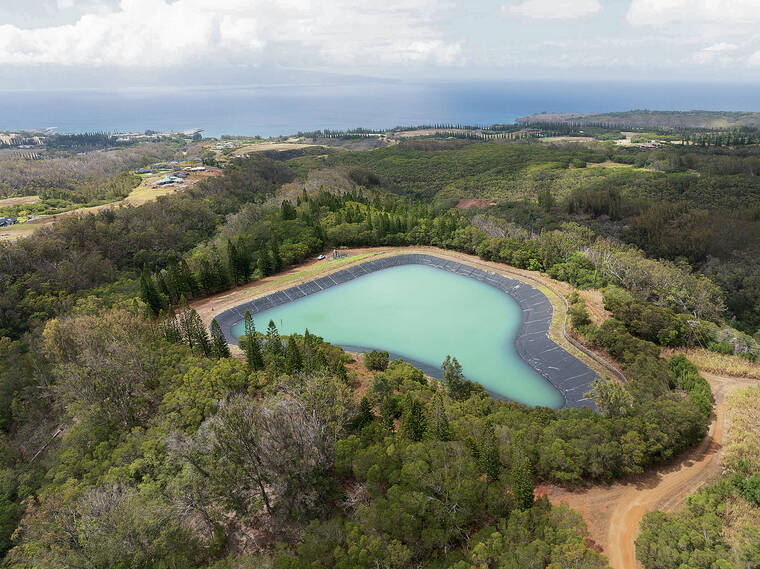By None
Copyright staradvertiser

Against a backdrop of water diversions and disputes over water use reaching back to the 19th century, and now burdened by inadequate supply intensified by repeated drought, Maui Land and Pineapple (MLP) wants to step away from its water system and assets.
The company had been seeking to lease its system to another water distributor. Last week, MLP ratcheted up its availability, stating it would sell its water infrastructure, including watershed lands — describing the sale as an opportunity to grow capacity, benefit the community and strengthen water security across Maui. At stake: a water system that includes water wells, irrigation ditches, reservoirs and transmission systems serving Kapalua Resort, Maui County and agricultural users in West and Upcountry Maui, with 10,328 acres of watershed conservation land.
Maui County has made clear that it’s interested — with a
Sept. 10 announcement that a County Council subcommittee was working to examine options for a buy or lease. That’s a step in the right direction, but must be approached with care.
The need is great, and there’s a clear public benefit in moving water delivery to public control. However, MLP’s system comes with liabilities that include unresolved legal issues and an indeterminate cost of repair — and the county must take care to avoid turning this into a bail-out. There are costly liabilities at stake, and these must also be scrutinized and negotiated over before any plan moves forward.
This summer, as drought conditions continued, water supplies dipped too low to serve all of MLP’s water users. The issue grew from urgent to explosive when on Monday, the annual PGA Sentry tournament at Kapalua Golf’s Plantation Course was canceled because the golf course had been dried to a brown stubble. In past years, the event had been touted as generating $50 million in spending and benefits to Maui’s economy.
The owner of two Kapalua golf courses, TY Management, sued MLP last month, joined by three Kapalua homeowners associations and a farm alleging MLP mismanaged water and damaged them by restricting water use in the past year.
Also last month, a Hawaii Supreme Court decision signaled continued close judicial attention to Hawaii’s “public trust” requirements for water management — a development that MLP has undoubtedly followed closely. Ruling that public input and protection of traditional water uses has constitutional protection, the high court held that the state Board of Land and Natural Resources (BLNR) was wrong to refuse a contested case hearing over water rights and restoration of water flows in East Maui.
The East Maui case has been rightly hailed as a victory for
community groups and Native Hawaiian rights, ensuring that traditional Hawaiian uses of water are taken into account. It sent consideration of a water use permit by Alexander &Baldwin back to BLNR.
In West Maui, the Supreme Court decision could mean that more scrutiny can be given to allegations of wasted water or harm done to taro farmers by MLP’s water diversions.
Private water companies must now take care to avoid acts that damage the public trust interest in water use — and there are potential arguments to be made that drying out a golf course valuable to the county’s economy or depriving taro farmers of water does so.
Combine the pressure on private water operators with Maui’s drought conditions and reduced rainfall over the past decade — which can create crisis conditions on their own — and there is powerful motivation to move forward in bringing Maui’s water under county control.
Hawaiians seeking to protect traditional water use and environmental activists have been seeking greater public input on water use on Maui for decades. But there’s been inertia at the county level, and plantation-era legacy water system owners have reaped profits from the status quo. But Maui is now at a crisis point for water use, with need to bring a rebuilt Lahaina back onto a water supply in addition to these other battles.
A sense of urgency is required to move forward quickly on these complex issues — within a framework based on the public trust doctrine. And “the public” must be understood to include Native Hawaiians and Maui’s kamaaina, who have a stake in maintaining the island’s sustainability and livability for future generations. Care must be taken to include them in decision-making.
Usage, maintenance and long-term planning decisions must be made with rigorous attention to all users’ needs, regardless of political influence, and to public benefit, incorporating Hawaiians’ historical water use and the necessity of preserving ecosystems supported by water sources.
With a commitment to the public trust mandate and standards for operation that place this commitment at the forefront, a shift to public control holds great promise for Maui.